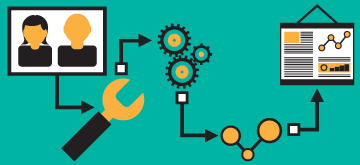Students often face problems accomplishing their goals because colleges and universities have poor processes. Service blueprinting, a type of process map, focuses on the student (or customer) experience and illuminates things an organization can do to identify and fix problem processes.

Nancy J. Stephens, Associate Professor Emeritus of Marketing and Faculty Associate of the Center for Services Leadership, Arizona State University
A Confusing Website
Director of Strategic Marketing & Communications Melissa Harris Thirsk stepped off the bus in downtown Phoenix and looked up at the new building housing Arizona State University's College of Health Solutions. One of her challenges was to attract students to the new college, with its programs downtown and in other locations. She knew that the strength of the college's programs would be a major selling point; for example, the Department of Speech & Hearing Science in Tempe was ranked highly nationally. She also knew that she needed to communicate the selling points clearly to prospective students, many of whom would be searching the Internet for information about the speech and hearing program. The website had to deliver an easy, convenient, and timely experience to searchers.
The "Towed Away" Nightmare
Melinda Alonzo, Director of Parking & Transit at Arizona State University, was reviewing the yearly operational data when one item jumped out at her: the number of vehicles towed from various parking lots at various campuses was almost 1,800 — about five vehicles every day. Alonzo quickly realized that this situation also created 1,800 unhappy students who now had to get their vehicles back, usually at considerable inconvenience and for high fees. This represented 1,800 negative student experiences that Alonzo, a believer in student satisfaction, wanted to decrease. She was well aware that students do not love the parking division, but she wanted to make its operations as smooth as possible for them.
Lots of Data, but Confusion Reigns
Carrie John tapped her pencil on her desk in frustration. She liked her new job as director of Analytics for Enrollment and Retention at the University of Colorado, Denver, and she actually enjoyed poring over all the enrollment figures, but still, something seemed to be missing. It seemed as though no matter how she calculated the data, confusion persisted. She also had been hearing complaints from students about their experiences not only with enrollment but also with registration, financial aid, and other service areas. She wondered if there was perhaps another way to look at the data.
Students Are Customers
Colleges and universities everywhere are coming to the realization that for nonacademic purposes, students are customers, and they must be appealed to and treated as such. Students clearly meet the definition of "customers" because they have money and choice among many different institutions. Thus, it is vital that college administrators consider the experience they offer their student customers. Like customers everywhere, students are most likely to enroll and remain in the school that offers them a good experience. And as graduates, they are most likely to recommend and support the school that treated them well and created happy memories for them.
The "student experience" can be defined as the sum of all interactions between student and institution from the time the student begins to investigate and apply to the school to the time s/he graduates. Obviously, there are thousands of interactions, both simple and complex, during a student's education. In order to create student satisfaction, each of these interactions should meet three criteria: they should be easy, convenient and timely.
The interactions that constitute the student experience are carried out by people (faculty and staff) and by technology (Internet, telephone, etc.). People may be on-site employees who deal with students face-to-face or they might be behind-the-scenes employees.
Interactions between student and institution can be viewed on a grand scale or a minute scale. For example, a small interaction might be taking a test, for which the student must complete the following steps: go to a monitored campus location, sign on to a secure computer, go through the questions and answer each one, submit the exam, and get results. In this "take test" example, we might raise such questions as: Is it easy to find and reach the campus test location? Is car or bike parking convenient? Is it easy to find the room where the test is offered? Is the assigned computer working? Does it respond quickly? What does the student have to do to get through the exam? Is it possible to go back and review answers after moving on to a new question?
Students will have a better experience, even with something as potentially negative as taking a test, if they do not have to worry about finding a parking space or being able to review their answers before submitting. That is, they will not experience additional stress. The goal, then, is to make the nonacademic parts of attending school as good as they can possibly be so that students have positive experiences.
To make every interaction a good one, administrators first examine what is currently being done and what resources — both financial and organizational — it takes to accomplish each interaction. They must figure out which interactions matter most and focus on those as the most important to examine and improve. Some sort of process map is needed, but one focused on student experience, not on cutting costs or achieving greater efficiency, although these admirable goals should be addressed elsewhere.
A Tool for Analyzing Interactions with Students
Service blueprinting, a type of process map, differs from most process tools by focusing on the customer or student experience and what the organization must do to create satisfaction. Its goal is to allow the administrator see things from the student's point of view; how does it feel to be a student trying to get to campus to take a test? Are there aspects of that experience that create dissatisfaction and exasperation? Why? How could those be changed? What would it take?
An Easily Used Website
Melissa Harris Thirsk explained how the confusing website for the Department of Speech and Hearing Science morphed to a simpler site that allows students to quickly find what they need.
"As we blueprinted the experience of going through our website, we could see that we were presenting people with masses of information that wasn't well organized. There were too many choices and no clues about how to navigate to the desired information. I wondered, would prospective students have the patience to go through all the clicks necessary to finding what they needed or would they become frustrated and move on to speech and hearing programs at other universities? Would they conclude that if it was this difficult to obtain simple information, what would the experience of the actual program be like?
"As a result of preparing the service blueprint, we drastically revised and simplified the website. We created fewer pathways, organized the information into logical categories, and made it so that prospective students could find what they needed with no more than three clicks. Our website offers a much better experience now."
Demo of service blueprinting the website
Towing Nightmares Tamed
Melinda Alonzo described how the number of vehicles towed from the ASU campus each year dropped more than 90 percent using service blueprinting.
"I put together a team to prepare a service blueprint of the vehicle towing process, from start to finish. The team represented each level of the blueprint — on-stage, back-stage, and support, and together, they were able to identify several points in the process that could be changed for the better, to benefit the student. For example, when a boot is placed on a vehicle, which means it has accumulated too many citations that have gone unpaid and is about to be towed, we would either wait for the student to discover the boot on the car and contact us, or we would call the towing company immediately and they would tow the vehicle away. For the student, of course, this is a horrible experience. After we drew the service blueprint, we saw right away some touchpoints that could be improved.
"The biggest change we instituted was to begin communicating with the student as soon as his/her vehicle is booted. We now send an electronic notice and advise students to call or come into the office and settle their accounts. Additionally, they receive one final notice on their vehicle that they are 'tow eligible' with a 72-hour timeframe to settle the account before the boot ever takes place. Doing this makes an unpleasant process slightly more pleasant, but the main benefit it delivers to students is preventing their vehicles from being towed off campus, which means they would need to find a ride to the tow yard to settle their account and retrieve their vehicle. This simple change has caused vehicle tows to decrease over 90 percent — from roughly 1,800 tows to under 200 each year. This process also saves time and is less adversarial. We consider that phenomenal."
Putting Data to Work
Carrie John discovered that a big part of changing the culture involves learning a common language.
"When we started service blueprinting, I realized immediately what was missing; we had spent hours and days looking at data, but we had never stopped to examine the process. By that, I mean we had never really looked, step-by-step, at what students must do to accomplish their goals of registering, enrolling, getting financial aid, and things like that. It opened the floodgate for all kinds of improvements.
"More importantly, though, is by having 126 people from 29 different units of our student services divisions participate, we were able to develop a common language so that when someone in the bursar's office talked about a 'moment of truth,' the technician in the information technology office knew what it was. It has allowed us to move forward in improving student experiences by establishing our students, and their perspectives and successes, as the center focus of how we work together to serve them. We have actually produced 114 service blueprints so far, and other parts of our university are asking to be involved, so we know we are achieving a culture change and we are thrilled."
Summary
Service blueprinting is a process-mapping tool that allows educational administrators to "see" the experiences and processes they give their students, such as what it takes a prospective student to navigate a school website or what it requires for a student to prevent a vehicle from being towed away. It is a tool that allows faculty and staff to develop a common language focused on student satisfaction, and in doing so, it may evoke a cultural change toward customer focus. Ultimately, good experiences will lead to positive outcomes in the form of better reputation, more recommendations to prospective students, and greater alumni support.
For More Information

To learn more about service blueprinting, visit the Center for Services Leadership website.
© 2015 Nancy J. Stephens. The text of this EDUCAUSE Review article is licensed under the Creative Commons Attribution-NonCommercial-NoDerivs 4.0 license.
